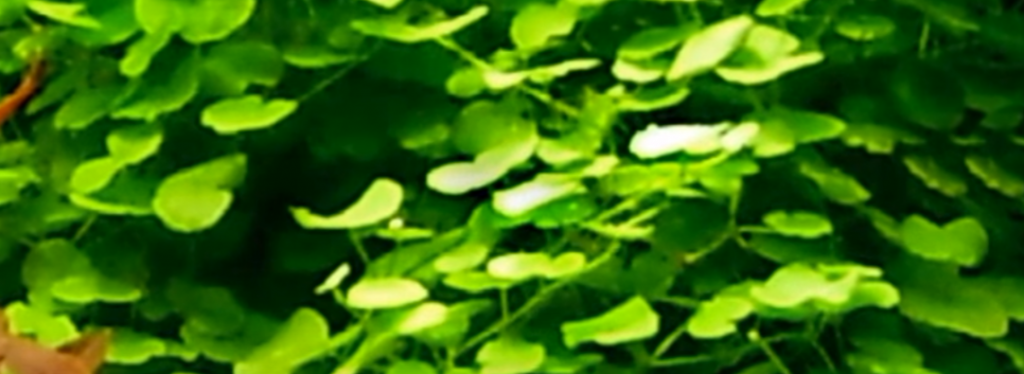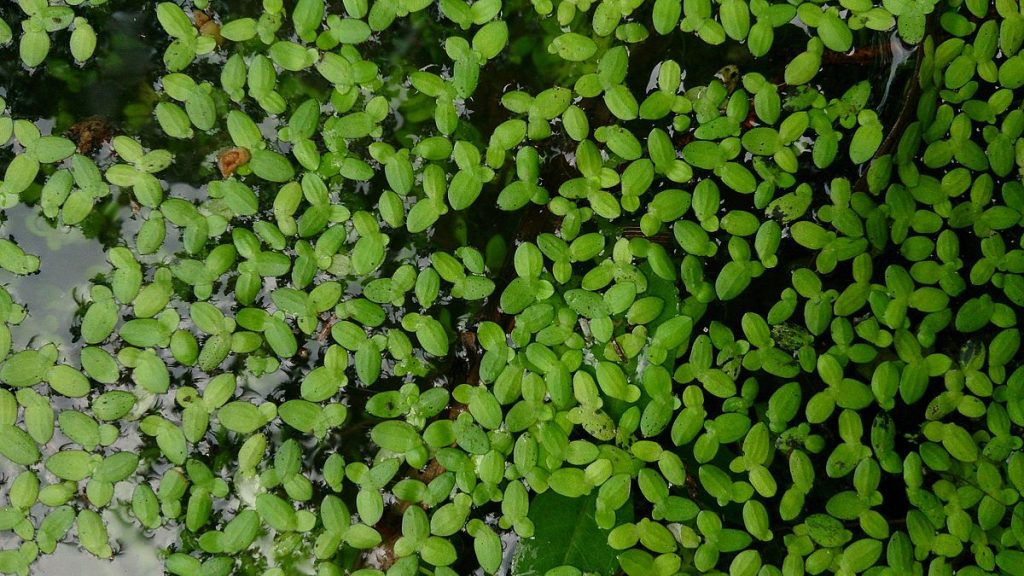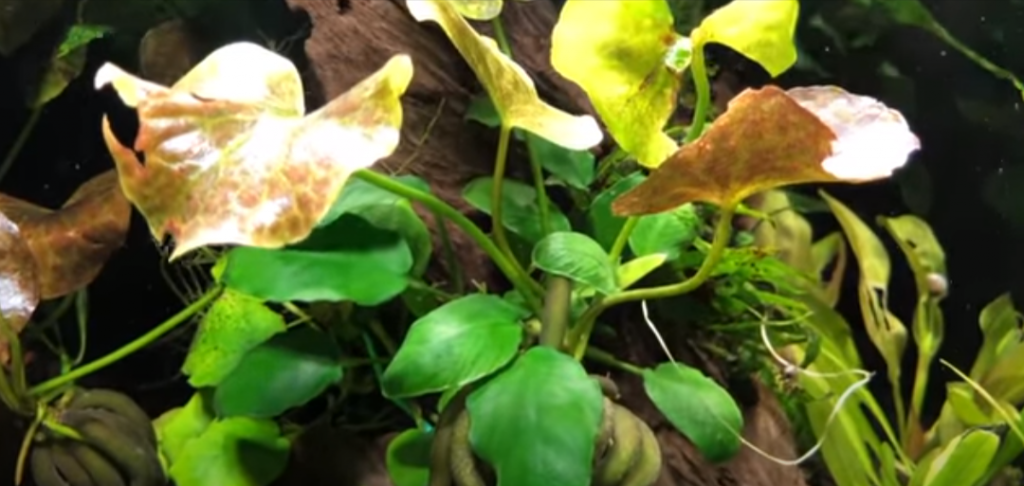There’s no doubt floating aquarium plants bring a completely new dimension to the tank dynamics. They are even better with the right fish species, offering guaranteed protection, shade, and even food to your favorite critter.
But which are the best options for a standard aquarium? In this guide, we cover the 15 best floating aquarium plants. We hope that after reading it, you will find a personal favorite to completely transform your fishkeeping hobby from the get-go.
1. Brazilian Pennywort
Brazilian Pennywort is a fascinating freshwater plant that’s fine as a floating option. They have lovely circular-shaped leaves that always spread all over the tank surface.

This attractive South American plant is ideal for elevating the tank’s general appearance and can act as an important protection for your favorite pet fish. Usually, the right care guidelines entail sufficient light, suitable substrate, and close monitoring.
The light conditions, in particular, help determine how large the plant grows. Under optimal conditions, this neat-looking floating aquarium plant will easily reach 24 inches in maximum height.
It’s worth reminding that with all its beautiful appearance, Brazilian Pennywort isn’t necessarily a suitable option for most labyrinth fish that entirely depends on the atmospheric air from the water surface.
2. Red Root Floater
As the name suggests, Red Root Floater is a natural floating plant that doesn’t seem to get enough attention from fish lovers around the world.
Just like the Brazilian Pennywort, Red Root Floaters originate from South America and can add such an aesthetic appeal to home aquariums that are not commonly seen with most plant types.
Their leaves display a beautiful red coloration, getting more intense under the right care. The red coloring extends to the roots and can be a wonderful addition to a standard aquarium.
Like most aquarium plants, caring for the Red Root Floaters always mean close monitoring to help them reach maximum heights inside the tank.
3. Duckweed
Duckweed is another neat-looking small-leafed plant that thrives in different conditions. They will be an interesting addition to home aquariums as a floating option that neatly spreads over the tank surface.

Typically, Duckweed appears like a neat cover of green leaves all over the substrate, with a steady growth rate that sees it hit heights of up to 0.5 inches in maximum growth.
Because of their even distribution all over the substrate, Duckweed is never a great option for the typical labyrinth fish and most creatures that rely on uninterrupted light supply.
That aside, proper trimming is a vital part of proper duckweed care and maintenance. And for anyone looking for a distinct look inside the tank, the Duckweed is always a great option.
4. Banana Plant
Banana Plant is another exciting aquarium plant that can be used as a floating option or submerged in the tank water.

It originates from the southeastern part of the USA and, just as the name suggests, has characteristic roots, usually representing the actual banana fruit.
They are a low-maintenance plant that can produce eye-catching flowers in full maturity, but that only depends on the level of care at home.
Banana plants are highly resilient, easily thriving under moderate light levels as long as you can commit to providing quality care. For that reason, they are a befitting option for beginner-level aquarists.
5. Water Wisteria
Water Wisteria is one of the most popular floaters that don’t rely on specific substrates to thrive. They need adequate light to grow and will easily float over the water surface with quality care.
But even if you choose to submerge it deep into the substrate, the Water Wisteria doesn’t seem to have any preferences.
What’s more, the thin, long leaves always stand out, with a plain green coloring that’s mesmerizing. The plant stems will be important to create multiple hiding places for your fish.
Be wary of their faster growth rate, which can sometimes see them spread all over the surface, almost outgrowing your aquarium. That almost means quality care will be absolutely essential to maintain your Water Wisteria in the best shape.
6. Anacharis
Anacharis is undoubtedly one of the most popular freshwater aquarium plants with its ease of care. These plants will always have a fantastic look with quality care, no matter your skill level.
And as a floating aquarium plant, they don’t rely on too much light to reach their optimal sizes. Besides, the Anacharis easily adapt to fluctuating tank water conditions, meaning you will enjoy some form of flexibility if you choose them as your favorite aquarium plant.
But whatever you do, never forget to trim your Anacharis to ensure their spotless appearance inside the tank doesn’t become a nuisance to your lovely pet fish.
A few fish will always want to use them as a supplementary meal, but that’s no call for concern because the Anacharis will always remain unaffected.
7. Water Sprite
Water Sprite is another readily available freshwater aquarium plant that’s easy to maintain. They have a fast-growing rate and can readily thrive with low lighting conditions.
Water Sprite is dominantly found in the tropical regions, and as a favorite floater, it is one of the best options for beginner-level aquarists.
Depending on your preferences, you can use it as a sturdy floater or as a submerged plant, deeply rooted inside the substrate. Either way, the Water Sprite should readily enhance the tank’s appeal while guaranteeing your fish’s comfort inside the aquarium.
As part of general care and maintenance, be ready to trim your Water Sprite occasionally to help them maintain their beautiful appearance for the long term.
8. Java Moss
Now, Java Moss is probably the most common freshwater aquarium plant, always sought after by beginner-level aquarists and advanced hobbyists alike.

While everybody agrees that it is one of the best-submerged aquarium plants, only a few understand that they can also be used as a typical floater. Even fewer are aware that they can be used with multiple fish species at any given time.
No matter your preferences, the Java Moss will always add an enticing look to the tank, with its oval-shaped leaves always requiring frequent trimming.
And by the way, because the Java Moss is commonly used as a submerged plant, it needs proper anchoring to thrive as a floating option.
9. Hornwort
Hornwort ranks among the most popular freshwater aquarium plants, which are easy to grow, beautiful, and low maintenance.
It suits newbie aquarists looking for a fast-growing plant that’s easy to maintain. The captivating green-colored leaves are particularly interesting, adding a unique feel to the tank at any given time.
Their uniquely thin leaves make them quite exceptional inside the tank, and when you use them as a floating plant, you can introduce just about any fish species you may have in mind.
Also, a Hornwort used as a floating plant requires proper maintenance, with frequent trimming always on the cards to help maintain them in the best shape.
If you ignore that, they could end up taking over your tank and putting your favorite fish under so much stress.
10. Amazon Frogbit
Amazon Frogbit, or simply Frogbit, is another popular large-leafed aquarium plant that’s a perfect alternative to the already mentioned Duckweed.

It is most commonly used in ponds, creating the perfect match with water lettuce and water hyacinth inside the same environment.
When used as a floating plant, Amazon Frogbit will create an alluring look inside the tank with its wide, sturdy leaves that match any aquascaping needs.
Of course, its ease of maintenance is one of the reasons you will want to grow it in the first place. That also makes it one of the best options for newbie aquarists or anyone looking to jumpstart their aquascaping hobby using a low-maintenance plant species.
And just to set it straight, the Amazon Frogbit wouldn’t be an excellent pairing for most fish species that don’t rely on bright light for survival.
That’s because the plant leaves will always spread neatly over the water surface, creating a dim environment that some fish species may not appreciate.
11. Mosaic Plant
The mosaic plant is a distinct-looking plant perfect as a floating type. Its dark green leaves tend to spread over the water surface, creating a neat-looking environment that’s widely appreciated by most fish species.

Also, they produce multiple yellow-colored flowers that add to their aesthetic appeal. Regrettably, the Mosaic plant requires significant space to thrive at home and is well suited to large tanks and outdoor ponds to reach its optimal size.
Mosaic plants require adequate light and can add a distinct texture to most ponds with beautiful, reddish foliage.
With their attractive look, we are always confident to recommend this plant to anyone keen to introduce a unique look inside the tank.
12. Riccia Fluitans
Riccia fluitans, sometimes called the floating crystalwort, is a beautiful floating plant that belongs to the genus Riccia.

They provide important shading and added cover to popular live-bearing critters and baby fish inside the tank.
While they are commonly found floating freely in outdoor ponds, these plants also exist as a thick matter over the tank water surface.
They flourish with added CO2 and other nutrients, and when planted inside a tank, the roots will always extend towards the surface, requiring good pruning from time to time.
A typical Riccia fluitans can grow up to 2 inches in maximum height with little to moderate light demand, depending on the nature of the aquarium.
13. Subwassertang
For Shrimp lovers, here’s the perfect floating plant for your beautiful little critters.

Subwassertang is a lesser-known plant species that thrive in the right conditions, and it is such a rarity that makes them an even more exciting addition to home aquariums.
They lack roots and don’t rely on tank substrate to thrive, readily floating inside the tank to create the unique feel they’ve become quite popular for.
They are not just impressive for their beautiful coloration. But also an exciting low-light aquarium plant that’s relatively hardy, especially after proper acclimatization.
Subwassertang is easy to maintain, never requiring much attention when fully adapted to the standard environment. Part of their hardiness also points to their easy growth, rarely requiring fertilizer application or CO2.
14. Salvinia Cucullata
Salvinia Cucullata is a low-maintenance water fern and one of the best floating options for a standard aquarium.

They are perfect alternatives to the water primroses with small leaves always filled with air.
There’s no denying the Salvinia Cucullata are less popular as a floating aquarium plant, but if you need uniqueness inside the tank, they will perfectly do the job.
They have short roots, and you will always see them draping into the water surface, creating a beautiful display inside the tank.
Salvinia Cucullata appears like thick matter over the water surface, blocking bright light from entering the tank. On that note, they aren’t necessarily the best options if your favorite pet fish wants bright light from the environment.
It is ideal for paludariums and aquariums, offering proper shade to your fish species while preventing unwanted algal growth inside the tank.
15. Water Lettuce
Water Lettuce is a popular name you will constantly hear in the aquarium trade. They often resemble the water hyacinth, with the two plants acting as the perfect substitutes to one another.

Water Lettuce is perfect for aquariums and ponds, providing a lot more than just beautifying the tank. As a favorite aquarium plant, the Water Lettuce will provide ample shading to your shrimps and baby fish while controlling algal growth.
Typically, Water Lettuce is well suited to tropical and subtropical tanks with a minimum size of 10 gallons.
While it will be a hardy option as a floating aquarium plant, Water Lettuce requires enough attention to maintain its pristine look inside the aquarium.
Final Thoughts
There’s something about the floating aquarium plants that makes them quite interesting to include inside home aquariums.
The 15 floating aquarium plants on our list are some of the best options you will find in the aquarium hobby. While some are strictly used as a floating plant, others double as beautifully submerged options.
And having included even the rarest of the floating species, surely there should be something for you from our expansive list. If you’d like to suggest other possible options missing from our list, we’d love to hear from you.


